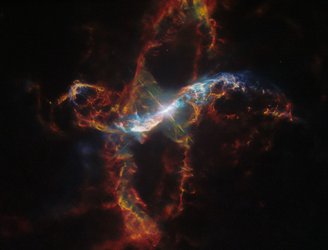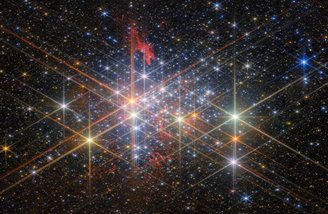Throughout October, the United States National Aeronautics and Space Administration (NASA), in partnership with the Canadian Space Agency (CSA) and the European Space Agency (ESA), released stunning images produced by data collected by the Telescope’s instruments. Webb Space Telescope (JWST) and Hubble Space Telescope.
For example, One of the images reveals a binary star system consisting of a white dwarf and a red giantcreating a cosmic landscape that looks like it was taken from a science fiction movie.
Check out this and other featured images from October!
Star cluster NGC 602
JWST used near-infrared (NIRCam) and mid-infrared (MIRI) devices to capture an image. Star cluster located near the Small Magellanic Cloud satellite galaxy, about 200,000 light-years away.
Called NGC 602, researchers suggest it is similar to those that existed in the early universe, with dark dust clouds and ionized gas.. The cluster is within a nebula of gas and dust, displayed in different colors due to James Webb’s filters.
“The presence of dark clouds consisting of dense dust and the fact that the cluster is rich in ionized gas also indicates the existence of ongoing star formation processes,” an official statement said.
Binary star R Aquarii
In the middle of the month NASA has unveiled a new image of the symbiotic binary star R Aquarii captured by the Hubble Space Telescope. Located about a thousand light-years from Earth in the constellation Aquarius, this binary system consists of a white dwarf and a red giant.

“R Aquarii experiences violent explosions that emit large amounts of glowing gas filaments. “This dramatically demonstrates how the Universe redistributes nuclear energy products formed deep within stars and ejected back into space,” explains ESA.
There is also a nebula around the star, extending in all directions in the image, predominantly in green and red colors.
Westerlund 1 star cluster
In another incredible catch, o James Webb presented the Westerlund 1 star cluster in the constellation Altar (Ara)It is approximately 12 thousand light years away from Earth. The region was first discovered by Swedish astronomer Bengt Westerlund in 1961, hence its name.

Westerlund 1 is a striking example of a stellar supercluster: it contains hundreds of very massive stars; some shine with the brightness of almost a million Suns, and others are two thousand times larger than the Sun (as large as the orbit of Saturn),” states the European Space Agency.
In an official message, ESA explains that the cluster has a population of exotic stars, some of which are too massive to exist as such in the Milky Way. So it’s a great region to study how physics works in such unique stars.
Did you like the content? So, stay updated with more astronomy related topics at TecMundo. Get the opportunity to understand how the Euclid Space Telescope produced a cosmic atlas. Until next time!
Source: Tec Mundo
I’m Blaine Morgan, an experienced journalist and writer with over 8 years of experience in the tech industry. My expertise lies in writing about technology news and trends, covering everything from cutting-edge gadgets to emerging software developments. I’ve written for several leading publications including Gadget Onus where I am an author.













